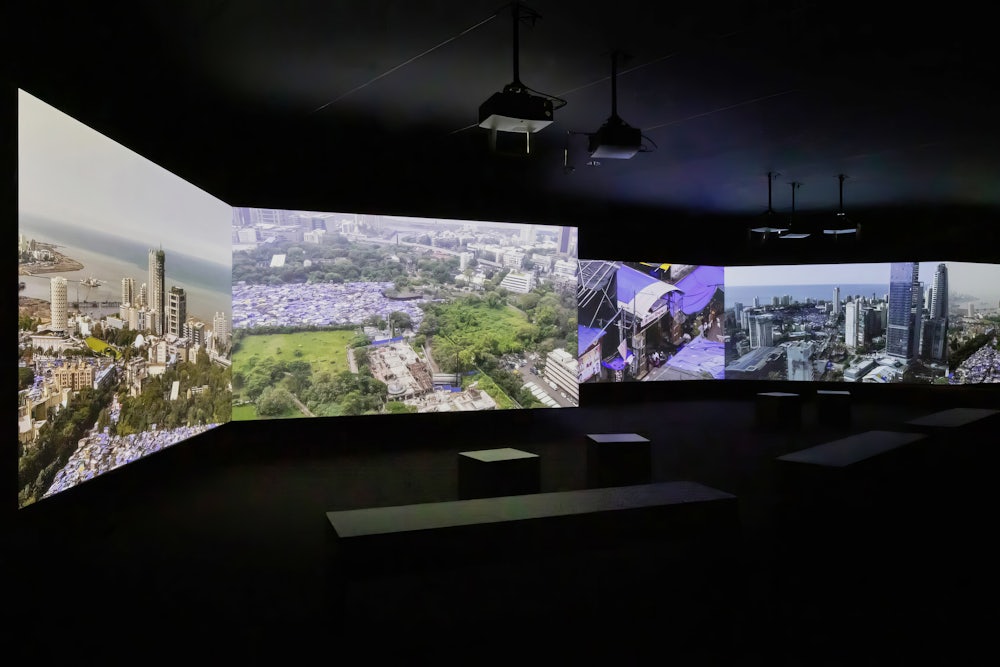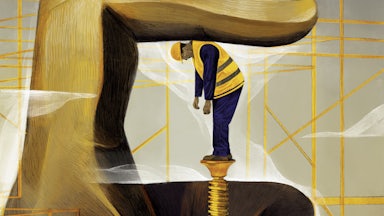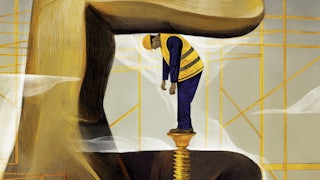The first website launched by the Mumbai-based collaborative art studio CAMP was called “camputer.org.” Every time you visited the homepage, a different meaning for the group’s acronym would pop up on-screen. Critical Art and Media Practice, Collaboration Across Metropolitan Permissions, Community Art and Marginal Philosophies; there were 100,000 possibilities. The founders of CAMP—filmmaker Shaina Anand, architect and artist Ashok Sukumaran, and computer programmer Sanjay Bhangar—would give out business cards with different names to different people: Challenges After Media Practices for documentarians; Comrades After Missed Promises to burnt-out activist-artists. It was a wink at the proliferation of NGOs in India, which packaged their West-funded humanitarian missions into trendy acronyms. CAMP, founded in 2007, did not presume a mission. It deployed a flexible, retrofitted acronym, or “backronym”: a sign without a referent, a parasite looking for a host.
In the two-ish decades since, CAMP moved on to a new website, but the spirit of the backronym—adaptability, fugitivity, ephemerality—has continued to animate the studio’s prolific new-media experiments. Members have commandeered CCTV cameras and control rooms to invert the gaze of surveillance in Mumbai and Manchester. They’ve used pirate radio and lo-fi cell phone videos to trace trade routes in the Indian Ocean. They’ve jury-rigged TV sets and security cameras to create interactive video networks in neighborhoods in Delhi and Jerusalem. They’ve created dense, digital commons of visual scraps, like indiancine.ma, an interactive database of movies, or pad.ma, an archive of outtakes from sundry film and television projects by CAMP and other artists.
Three of these projects are on display at a new show at the Museum of Modern Art in New York, titled “Video After Video: The Critical Media of CAMP,” where the entryway hearkens back to CAMPuter.org: A wall projection cycles rapidly through CAMP’s many possible full forms. I first visited the show in early March, when techno-pessimism suffused the air like smog. In the weeks before, X owner and SpaceX founder Elon Musk had begun gutting federal agencies in his new role at DOGE, a.k.a. the Department of Government Efficiency. Amazon owner Jeff Bezos had ordered The Washington Post’s opinion editors to crusade for “personal liberties and free markets.” Meta CEO Mark Zuckerberg had begun his blatant pivot to the right, with the company dropping policies to combat hate speech on its platforms. The tools that had once promised freedom and democracy seemed unabashedly and decisively to have become those of control and capture. But CAMP’s irreverent, hacktivist projects flicker with a resilient sense of possibility—a reminder that the medium can be severed from its message. High-tech infrastructure becomes pliable in this work, massaged to new ends by the lowest of low tech: wires, rigs, hands.
There is a word in Hindi for this kind of MacGyvering, upcycling, pirating: jugaad, a concept that translates loosely to “making it work.” In an under-resourced country, where corruption and inequality have rendered most things unworkable, jugaad is how many people survive—by making homes out of cardboard and tin, stealing electricity from power cables, sterilizing medical instruments in pressure cookers. But jugaad is also a kind of neoliberal Stockholm syndrome, where the response to state abandonment is to “do it yourself”—to innovate oneself out of a broken system, which, of course, only shores up the system. Recently, I saw the word in the comments under an Instagram reel that showed people walking nonchalantly on a thin plank placed across a crevasse in a road in North India, full of sharp rebars poking upward.
If CAMP’s projects “make it work,” they also ask, “for whom?” One of the exhibits in the show at MoMA, titled “Khirkeeyaan,” was directed by Anand in New Delhi in 2006. For this series of seven short films, Anand set up four-way video connections between various spaces—homes, barbershops, bodegas, workshops—by mounting cameras on top of television sets, and hooking them all up using CCTV and cable TV transmitters. In each instance, the inhabitants of the four networked spaces were invited to chat with one another via this setup, as if on a proto–Zoom call; their exchanges were recorded and then edited into short vignettes. (The neighborhood where Anand conducted this project, Khirki Extension, is itself a backronym of sorts: The area was not zoned for residential use, but so many workers and migrants, unable to afford housing elsewhere, settled there over the years that the government was forced to eventually legitimize it with municipal services.)
At MoMA, these conversations loop on three monitors, and on the wall behind them, a line diagram illustrates how it works. The technology is simple, physical: coaxial cables snaking in and out of homes, linking neighbors who lived and worked in close proximity without ever encountering one another. In one of the episodes, a leatherworker asks a tailor where he is located. “Right in front of you!” the man replies. He is in the basement of a tall building just across the street, hidden away from the eyes of his neighbors during his 12-hour workdays. “Khirkeeyaan” was undertaken at a time when CCTV cameras and satellite TV were just becoming common in India, on the heels of the economic liberalization that had taken off in the late 1990s. They were, along with Western brands and special economic zones (not to mention NGOs), signs of a new era of communication, connection, and efficiency. But at the same time, in cities like New Delhi, gentrification intensified, surveillance became omnipresent, and the commons were whittled away.
By transforming technologies built for one-way consumption—the CCTV consumes; the TV is consumed—into a communicative medium, “Khirkeeyaan” fashioned makeshift public squares. In the videos, women trade tips on handling alcoholic husbands and reflect on being migrants in Delhi; men exchange jokes, poems, and ideas for collective action against development projects; workers sing for one another while toiling with their hands. A sense of shared conditions emerges—I’m tempted to say organically, but that is the kind of uncritical documentary-speak that is anathema to CAMP. Unlike nonfiction artists who fetishize the camera’s ability to capture a self-evident reality, Anand recognizes that to make images is to reorient social relations: In one of the episodes, she even inserted an actor to steer the conversation after the interactions between a shopkeeper and some workers turned casteist.
Orientation is key to another project on view, which explores two very durable mediums of global communication: airwaves and oceans. Both conjure visions of infinite freedom but are tightly regulated, depending on where you’re coming from and where you’re going. Back in 2009, CAMP created a publication, Wharfage, which inventoried the myriad items ferried by wooden boats, or dhows, from the Gulf of Kutch in India to Iran and Somalia, via free or cheap ports in Sharjah and Dubai, traversing routes that more official traders were unable to travel then, whether due to geopolitical sanctions or fears of piracy. A complementary radio station allowed sailors at the various ports to communicate—share songs, stories—and visitors to tune in. That project gave rise to From Gulf to Gulf to Gulf, an 83-minute film stitched together from playful, low-res videos shot by the seafarers on their cell phones and often set to Bollywood music, forming an intimate and impish portrait of labor and leisure in a borderless realm.
At MoMA, the film plays on a wall-size screen, the pixels undulating like drops of water. (It’s also available to stream on the museum’s website.) At large scale, it makes visible the low-tech and corporeal infrastructure of global exchange—underpaid people laboring with their hands, handmade wooden boats facing rough seas—that still drives the world economy, despite the idea of bloodless, sweatless automation sold to us by the tech industry. Anand told me that she once encountered a bootlegged DVD copy of the film in a street market in Karachi; it had traversed the same underground circuits it traced.
The most recent work in the show at MoMA is a six-screen installation entitled “Bombay Tilts Down,” which utilizes footage from a high-definition CCTV camera mounted on the thirty-fifth story of a skyscraper in Mumbai during the pandemic. The screens are arranged side to side, their borders meeting at irregular angles to form a stretched-out accordion. Each screen features an uninterrupted take of the view from on high. On one, the camera pans down the length of the Palais Royale—one of the many illegal skyscrapers in Mumbai, built on land where a textile mill once stood—to squat slums covered in bright blue tarpaulin. On another, the camera captures the Indian Ocean, dotted with cargo ships, in a slow, sideways pan. On the other screens, the camera slithers its gaze up or down parks, construction sites, and crowded roads. As the 13-minute video sequence plays on the screens, the room vibrates to the beats of a soundtrack that mixes protest songs with a deep bass. Lyrics are projected on a wall to the right of the installation.
You cannot take in all six screens in their entirety from any vantage point in the room; the view is always warped and incomplete in a thrilling city cacophony, where the contradictions of scale that threaten to pull the metropolis apart are palpable. The specter of the backronym returns: In “Bombay Tilts Down,” the purpose and position—i.e., the orientation—of CCTV is reversed. Instead of peering out from private spaces to locate encroachment by the public, it locates encroachments by private entities on public land. It does not anticipate crime; it gazes at scenes where crimes have already taken place. In interviews about the installation, CAMP members have invoked Japanese landscape theory, or fûkeiron. Developed in the 1960s by filmmakers like Masao Adachi and Nagisa Ōshima, landscape-theory films captured political power as something diffused in everyday landscapes, rather than embodied or enacted by specific individuals or exceptional events. A classic example, Adachi’s A.K.A. Serial Killer (1969), entirely comprises shots of the landscapes inhabited by a 19-year-old Japanese murderer; neither the man nor the incident is pictured in the movie.
There’s something less abstract at play in “Bombay Tilts Down.” While filming with the CCTV camera, CAMP equipped passersby on the street with the capability to manipulate the device’s patrol—its angles, movements—and stream the results. At certain moments, when the camera reaches its lowest tilt, you can see pedestrians at the edge of the frame pointing up in a silent gesture of accusation. The film is both simple in its conceit and complex in the affects it provokes. Power is indeed diffuse, lurking underneath all the surfaces of the city, but also direct, visible, and concrete: You can point your finger at it. CAMP reminds us that the visions of totality and inevitability conjured by today’s technocratic systems are illusions. Those who make them work can also make them unwork. You just need to know which way to look.






